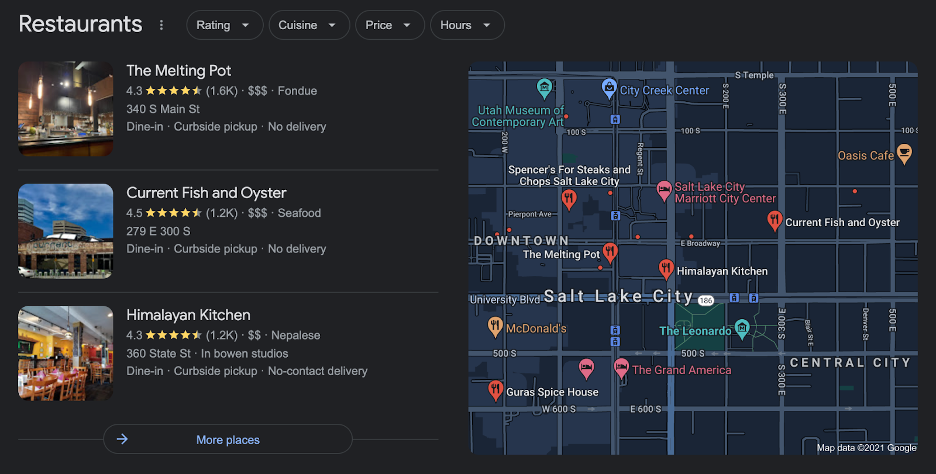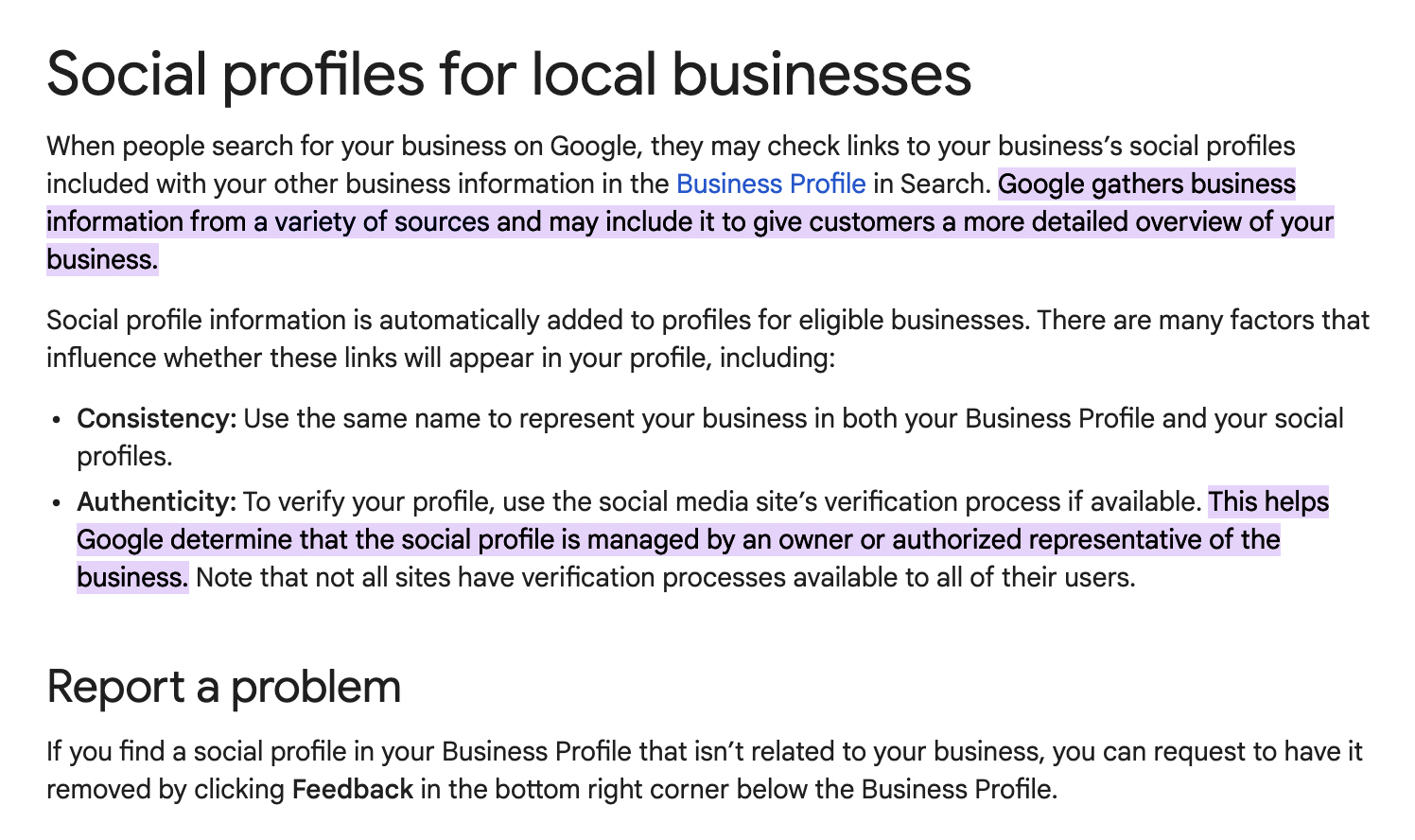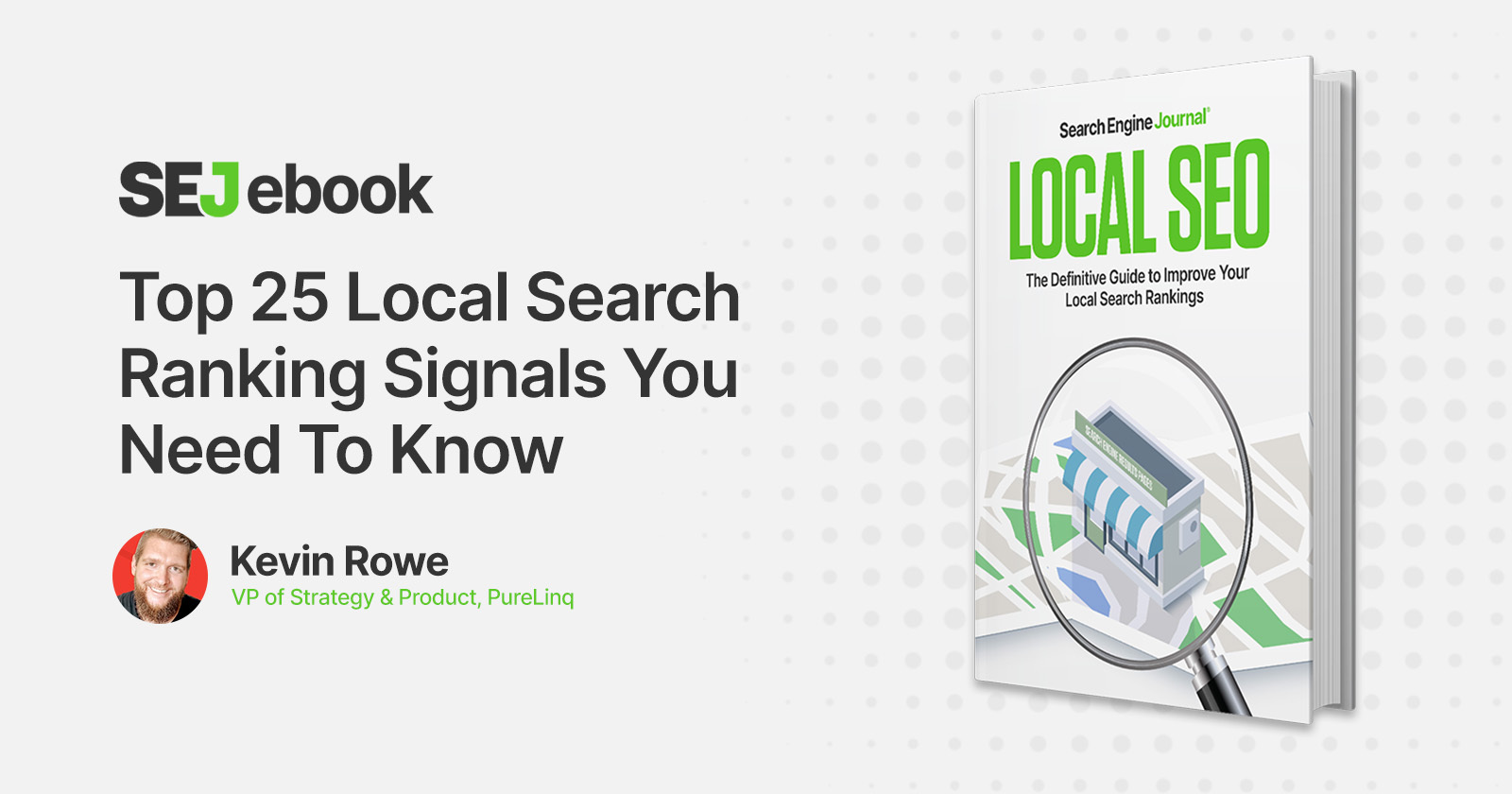Getting a local business to rank is challenging for three reasons:
- An uptick in mobile uses because more people are using their phones to find businesses near them.
- A surge of businesses recognizing the value of local SEO are making results more competitive.
- Google Local Pack, which was once the top seven, is now just the top three.
So, what does it take to appear at the top of these competitive local results, to get you in front of the people searching for products and services like yours?
Here, you’ll learn about 25 specific local ranking signals you need to understand and optimize for in order to perform as well as possible in local search.
First, let’s take a look at how these changes with Google’s Map Pack/Local Pack are a game-changer for businesses.
Recent Map Pack Changes You Need To Know
Google’s Local Pack is where a searcher makes a query with local intent and Google’s three most relevant results show up above the organic listings.
The importance of the Local Pack tool is evident in that Google is constantly modifying the Local Pack to be more useful to searchers.
For example, Google recently announced that they are rolling out to the search interface on desktop that when people search for places or businesses nearby, such as [restaurants near me], they’ll easily see local results on the left and a map on the right.
Here’s an example of how that search would work:
 Screenshot from search for [restaurants near me], Google, November 2021
Screenshot from search for [restaurants near me], Google, November 2021It allows the searcher ultimate convenience to quickly find a business near them and see hours, phone numbers, reviews, and more without clicking through a website.
Ranking locally for your business is vital and local SEO must be a critical component of your overall optimization strategy if you hope to increase your odds of getting ranked in Google’s Local Pack.
As with all things Google, there is no exact formula for getting to the top and the competition is fierce.
But, this article will outline important steps you can take to build your local online presence and increase your chances of ranking well as a local business.
What Are The Top Local SEO Ranking Signals?
I have organized the list of critical SEO Ranking Signals into two broad categories:
- The Basics: This covers the most foundational ranking signals. These are the low-hanging fruit and the fundamental factors that must be addressed to rank for SEO.
- The Nitty-Gritty Local Ranking Signals: This outlines the more advanced local ranking signals that you’ll need to move to the top and outrank a competitor.
The Basics
1. Google Business Profile
You may know Google Business Profile by its previous name, Google My Business.
It is easy and free to claim your Google Business Profile.
This is one of the simplest and most effective ways to improve your local SEO.
There are two methods:
With the first, you enter the name and address of the business and choose it from the search results.
With the second method, you find your business on Google Search or Google Maps and click “Claim this Business.”
2. Google Business Profile Categories
Categories describe your business and help you connect to the customers who are looking for you.
Choose a primary category that describes your business as a whole and be specific.
For example, if you are a nail salon, select “nail salon” rather than just “salon.”
3. Photos On Google Business Profile
You can add photos or videos to your Google My Business Page. These could include your location, products, staff, and even customers (with permission, of course).
Photos can add interest and credibility to your listing and also serve as a local ranking signal.
4. Bing Places For Business
Google is the most commonly used search engine, but Bing still holds a small share (about 7% of the world market according to this source).
Cover all the bases by setting up your Bing Places for Business.
5. Online Directories/Citations
Claim your business in other popular online directories, such as these:
- Apple Maps.
- Yellowpages.
- Foursquare.
- Yahoo’s Localworks.
6. Listings On Review Sites
A study by Harvard Business Review shows the power of listings on review sites.
Their findings were that a business’s one-star improvement in YELP rating leads to a 5-9% increase in revenue.
To get reviews, start by getting listed on these sites:
- Yelp.
- Glassdoor.
- Angie’s List.
It appears that reviews on Google carry the most weight, but listings on these other sites are still very valuable.
7. Number Of Positive Reviews
Achieving positive reviews and interacting with your customers by responding to their reviews is important.
According to Google, high-quality reviews help the customer by improving your business’s visibility and increasing the likelihood that a customer will visit your location.
 Screenshot by author, November 2021
Screenshot by author, November 2021Don’t forget this important caveat to this recommendation on seeking positive reviews: It is against their policies to buy reviews by asking for reviews in exchange for something else.
Other sites, such as YELP, similarly have policies in place against manipulation with the goal to keep the reviews authentic and unbiased.
8. Reviews With Keywords And Locations
Not all reviews are created equal.
When reviewers use the city or keywords, it sends signals to Google that you are a trusted local business.
If you have many products or services, it’s recommended to have your customers send them in individually and according to the specific product or service that they have.
9. Reviews With Responses
Owner responses to Google show that the page is actively managed and that you are engaged with them.
Google has also indicated that your replies are important because reviews build trust.
10. Percentage Of Negative Reviews Not Responded To
In a double whammy, the number of reviews with responses counts, but so does negative reviews with no responses.
You need to have a plan in place for responding to all reviews and particularly negative ones. Read here for more guidance on how to handle negative reviews.
Google has set up a system if you believe there has been an inappropriate or negative review on Google and want to get it removed.
11. Create A Facebook Business Page
Many people are comfortable with Facebook and use it as a search engine, so it is on this list.
Make sure you at least create a business page and update it with your website, hours, and a description.
Social signals may have a limited impact but they do have an impact on social SEO.
 Screenshot by author, November 2021
Screenshot by author, November 202112. Social Listings
Whether you plan to be active on social listings or not, you should at minimum claim your business on all of the popular social sites such as Twitter, LinkedIn, and Instagram.
Pin a tweet or post inviting users to call/visit your website/follow you on whatever social platform you are most active on.
In a survey of 3,200 customers, the average customer expectation of response time was four hours!
With an expectation of fast response from businesses on social, short turn-around replies, your business needs to reply lightning fast to meet this expectation.
13. Consistent Name, Address, and Phone Number (NAP)
Be consistent with your business name, address, and phone number through every medium to allow Google searches to provide accurate information.
Also, a consistent name, address, and phone number can make it easy for your customers to connect with your business.
Attention to detail here is important.
For example, if your business name is Jon’s Burger, LLC on one site and Jon’s BurgerS on another site, the slight difference in name and entity could cause confusion.
14. Mobile Responsiveness
Google looks at your mobile site first, not your desktop site. This tool can help you get started on achieving mobile responsiveness.
The Nitty Gritty Local SEO Ranking Signals
15. Structured Data Markup
There are several ways you can use structured data markups for local SEO, including for:
- Multiple departments.
- Hours.
- Address.
- Menu.
- Website.
- Phone number.
These are highly recommended by Google. You can add markups using Google’s guide or a tool like Schema.
It is also worth noting there is some lack of clarity on whether including GPS coordinates within structured data is helpful.
See ‘How to Use Schema for Local SEO: A Complete Guide’ for use cases and sample markup.
16. Click-Through Rates From Search Results
If you are succeeding at SEO in general, you will do well in local SEO. Makes sense, right?
Focus on making sure your meta titles and descriptions make sense so users find what they expect when they arrive at your site.
17. Localized Content
Consistent publication of content is key here. Set a goal for ongoing content and measure your progress to ensure results.
Make sure you can organically include your key term and location.
For example, write about local events, share efforts to raise funds for a local charity, include information topics important in the local community, etc. Think about what makes sense for your brand.
18. On-Page Location + Keyword Optimization
For example, don’t just optimize for “furnace repair.” Optimize for “furnace repair Sacramento.”
19. Title + Meta Description
Include key terms and location in your title and meta descriptions when feasible.
This is in coordination with on-page location plus keyword optimization, but it is important enough to warrant mentioning separately.
20. High-Quality Inbound Links
Links from sites Google trusts are good for SEO. The topic of inbound links is important and extensive and a deep discussion is beyond the scope of this article.
Learn more in this local link building guide.
21. Diversity Of Inbound Links
You want a range of inbound links that are relevant, authoritative, and gained organically.
A good analogy in an investment portfolio. You would want diversification of different types of investments and different levels of risk.
Your link strategy should be similarly diversified.
You want as many links as possible from as many different websites as possible, with the note that you want all of the links to be high quality.
22. Inbound Links From Local Relevant Sites
Links from local news sites, community blogs, and so forth prove that your site is trusted by your neighbors.
For some businesses, a press release to local news stations could help here. For others, engaging in discussion on local social media sites might be helpful.
23. Inbound Using Local + Keyword In Anchor Text
Are you ready to set a hard goal?
An inbound link from a high authority site using both your city or neighborhood and the main key term is like the “holy grail” of links.
24. Proximity To The Searcher
Your proximity to the searcher is what it is, and you can’t optimize this factor.
However, it is a strong ranking signal, which is why claiming your Google Business Profile and having a consistent name, address, and profile is important.
25. Domain Authority To Your Website
Domain authority is a search ranking authority developed by Moz that predicts how likely a website is to rank.
Increasing your domain authority isn’t a quick or easy process, but it is likely to pay off handsomely.
Conclusion
What do all these local SEO features mean for your local SEO strategies?
Here are the two major takeaways:
- Your Google Business Profile is the first and most important place to start to optimize your local SEO ranking. Claim it. Make sure it’s complete and accurate. Choose the categories. Get reviews. Respond to reviews.
- The second most important thing you can do for local SEO is to focus on a big-picture, holistic SEO strategy. Build a high-quality link profile, create useful well-researched content with both local and key terms, and make sure your meta descriptions are optimized.
Local SEO is a competitive field, but for most businesses, there is still room for growth and improvement.
This list will help you increase your chances of being included in Google’s Local Pack, but most importantly, it will help increase your ability to be found by and connect with local customers.
Featured Image: Paulo Bobita/Search Engine Journal




